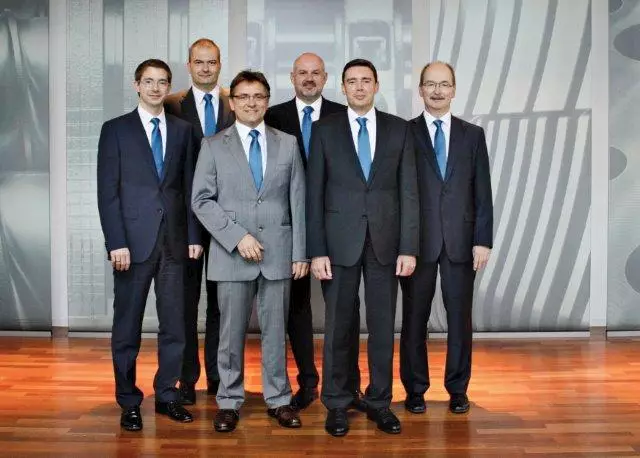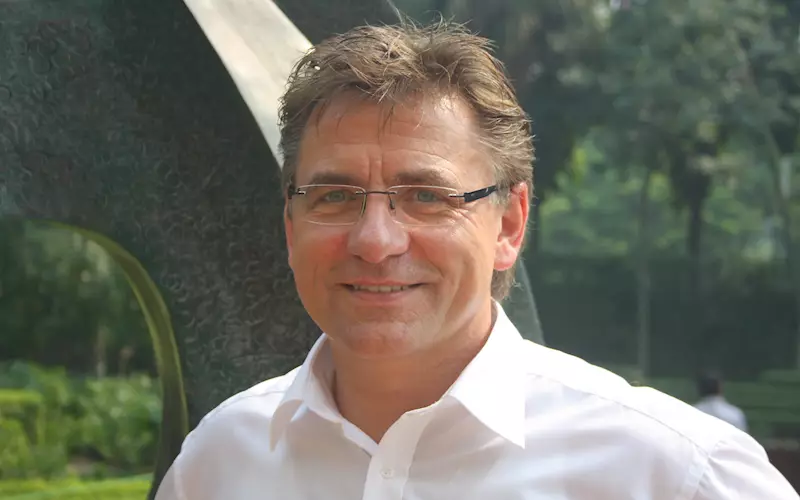Manroland’s managing director Eckhard Horner-Marab was in India recently on his first international market assessment before the strategy planning board meeting in Germany. Rahul Kumar and Supreeth Sudhakaran engaged in a discussion to understand his vision for the new Manroland brand post-insolvency.
PWI: You have a masters in engineering and 25 years of experience. How will you implement your knowledge at Manroland?
Eckhard: Manroland was recently downsized from over 2,400 people to 1,400 people. This means that we are no longer a listed company but a mid-sized company. All through my career I have worked as in-charge of mid-sized companies in different segments. The necessities of a mid-sized company are different from that of a listed company. You have to simplify the business processes.
PWI: How?
Eckhard: Mid-sized company has a very lean management structure. This gives you the opportunity to focus more on customers rather than the interest of investors. In a listed company, a lot of resources are employed in getting the ‘right figures’ on a quarterly basis. A mid-sized company is much more flexible, reacts faster to customer requirements, and everybody in the organisation is doing adding-value.
And taking that in consideration, I believe that we can be successful in implementing our goals and plans. The main task for Manroland now is to speed-up it’s time to market and complete our portfolio; especially from top-down to entry-level products. This is in addition to taking measures for reducing costs and complexities.
PWI: Can you share your two month-old experience within the printing industry…
Eckhard: I have met several customers in Germany. India is my first visit outside Germany. For Manroland, India is a very important market. From what I have seen, Manroland is excellently positioned in the market. In addition to India, China is a strong market for us. We are expecting a CAGR of 6% in India for Manroland in the coming years, and this is extremely high compared to the matured markets of Western Europe where the growth is almost stagnant.
PWI: This being the first fiscal year after insolvency Post the insolvency has there been a shift in the Manroland brand, worldwide and especially in India?
Eckhard: The answer to your question is simple, but to arrive at the results we had to toil real hard. There have been some rumours in the market during the insolvency period, but the velocity with which Manroland has bounced back is commendable. Our loyal customers still believe in us, and the most simple measurement of the same is the number of orders we have received in the last eight months. At the same time, I reiterate that there is lot of homework for us to do to strengthen our stronghold on the market.
PWI: What is your first course of action?
Eckhard: ... to ensure that the loyal base of customers doesn’t retract. And I believe that they did a wonderful job in this because not one customer cancelled the order. In addition, customer expectations in agreement of the clauses in the contract signed with them were fulfilled in the promised time frame. We have not only re-structured, but also re-organised the whole process. We have been able to put across the message to our customers that the insolvency has not stopped us from innovating. Only eight months after insolvency we are expecting a slightly positive result at the end of this financial year. And for a company to emerge from insolvency and recuperate this fast is amazing.
PWI: Any impact in India?
Eckhard: A sign of this is the order we received from The Times of India during Drupa. These are trend-setting companies in India, and when they put in their faith in Manroland during an adverse situation, it sets a first class example of relations we share with our customers.
PWI: Manroland provides web printing solutions, consumables, software, workflow management and digital printing, how does the company manage the portfolio?
Eckhard: It is not difficult to manage this portfolio. We are still spending 5% of our revenues on R&D, which is comparatively higher than the industry average. Manroland today has to re-think its product portfolio and understand if we have the right products to serve the market.
PWI: What will be the next segment you will serve?
Eckhard: We are planning to focus on special service products. Maybe we did dwell in too many directions, without a strong focus in the most profitable segment, so the question we face is to focus on activities where you get immediate ROIs. This might also mean that we would have to close few activities and focus the resources on the other.
PWI: The first made for India, Cromoman 4-1 printing press is in production at the The Times of India plant in Pune. According to Manroland, India is a primary market for the Cromoman 4-1 press; but the 2x1 presses have been popular as well. Why does Manroland think that India is a primary market for Cromoman 4-1 press?
Eckhard: Cromoman 4x1 is specially designed for India. This is a typical example of excellent relation with a customer. The design of the press was born out of ideas originating from customer requirements and feedback. They are so experienced with the engineering of presses that they could point out the most critical necessities they have been seeking in presses. Manroland decided to go step-by-step from top to bottom when developing new presses, so currently the focus is on developing 4x1 presses. And the way Cromoman was developed (by talking to customers and understanding the press conditions of the country), I believe it is the appropriate approach for developing a product. A typical old-fashioned engineer used to sip a cup at the office – and design the machines. Today, the product development is market-driven.
PWI: Being one of the foreign manufacturers, what changes you have seen in the market and printers’ adoption of new presses? Do you see a boom in Indian printing industry?
Eckhard: I don’t foresee a print boom in India because according to me that warrants a growth rate of more than 10%. But the growth in India is on a sustainable curve.
PWI: What is the outlook for Manroland in 2013? Is the market picking up?
Eckhard: I am not listening to what my competitors are doing. My current focus is to shape the organisation better and focus on our core competencies. The first and foremost thing on our list is to make the company profitable. We are expecting an overall growth for Manroland in 2013. That means that we need to capture more markets for long-term profits. We already have set a net sales target of 300mn Euros; of this a healthy portion has already been met.
PWI: The revenue of newspapers and publishers saw a considerable fall in advertising revenue. Do you think the market will pick up and be able to sustain itself?
Eckhard: This is more a question of innovation. The ones with good ideas, which are also practically implementable, will grab the market. I have seen several innovative designs and creatives in Indian newspapers which are interesting for customers. A trend I have been seeing is regionalisation of newspapers. For instance, WAZ is a big conglomerate of newspapers in Germany. They have brought in regionalisation of content and even advertisements pertaining to a specific region. This is something that India is also moving towards. Around 70% of Indian population still doesn’t have direct access to newspaper so for the newspaper industry; there is a huge opportunity.
PWI: What is your share in thee Indian pie of web presses? And what is strategy for emerging markets?
Eckhard: We are still working on our strategy for the emerging markets. In next three months, we will be in a position to talk. Recently, we had an open house in Times of India’s Pune plant for our customers. We had expected around 60-70 customers to take part in the open house, but were overwhelmed to see 100 customers at the plant.
PWI: When will we hear about customers other than BCCL?
Eckhard: We do not have only TOI as customers. Hindustan Times is a customer, as well. There are several customers on the commercial sites, who have the Cromoman 4x1, we hope to bag more big customers in the near future. This is a very strong target for our sales team and I am hopeful that they would steadily strengthen our market standing. For the regional markets, you have to have the right products. With our presses we are talking about over 2,00,000 copies a day. To cater to the smaller Indian language publications, we need to have a product that suits their needs.
PWI: Is there any competition with Indian manufacturers due to their local and cheaper technology?
Eckhard: In India there is a lot of competition in the web presses. I have heard that there are approximately 20 manufacturers functioning in India. However, we have not been affected by this competition as we cater to the top segment, while the Indian manufacturers are focusing on the lower segment. But this might affect our entry-level product strategy that we are working on.
PWI: Do you have any plan to start a manufacturing facility in India or in Asia? Or will it be an export-base model only?
Eckhard: It is too early to dwell into this. We are concerned about making the company more profitable. Currently, the most viable model for us is to stick to the export-base model. However, I must add that in the future, to be successful in a market like India, it would be important to have some local content available.
PWI: What is your outlook going forward? Do you think the Cromoman, Uniset, Regioman, Geoman and Colorman are going to be your star thoroughbreds in the stable for 2013?
Eckhard: Yes. We have a strong portfolio in the segment, and at least for 2013 we will go with these models.
| Manroland’s timeline – 2012 |
|
January L Possehl & Co mbH, Lübeck, comes forward as the investor for Manroland web systems
February: L Possehl & Co mbH signed the contract for the acquisition of the web offset press business located in Augsburg. New management team is set in place at Augsburg and Manroland web systems buys over the subsidiaries Manroland India and Manroland Australasia
March: Possehl purchases Manroland Great Britain’s web business
April: Possehl and Langley agree on global sales and service cooperation
May: Manroland web systems participates in Drupa with a new owner Possehl and signs multi million euro deal with The Times of India
June: Manroland launches the new press operating concept successfully
July: Manroland web systems invests in company grounds
August: Manroland web systems participates at Graph Expo 2012 and announcement of Eckhard Horner-Marab‘s appointment as the managing director of Manroland web systems
September: Eckhard Horner-Marab joins as the managing director of Manroland web systems and Manroland web systems conducts the open house of the Cromoman 4-1 at The Times of India, Pune
October: managing director Eckhard Horner-Marab introduces himself in Augsburg, Germany, visits the world market organizations of Manroland web systems. Manroland web systems participates in IFRA, Frankfurt
November: Manroland India and Bowe Systec announce new sales and service partnership in India
|

Team Manroland - simplifying busines process











 See All
See All